 In a previous post, I included the scan at left from a 1969 issue of the AES journal. It’s an ad for the Gately Electronics EM-7 4×2 mixer and EM-7 4-channel equalizer. At the time I had hoped to find one of these little setups, and sure enough, one of the EM-7 mixers came along on eBay. I checked the sellers ‘completed listings’ and saw that he had sold the companion EQ-7 equalizer unit earlier. I contacted that buyer through eBay, indicating that I was interested in the EQ-7 should he decide to part with it. Sure enough, he did. So I was able to get an EQ7 as well.
In a previous post, I included the scan at left from a 1969 issue of the AES journal. It’s an ad for the Gately Electronics EM-7 4×2 mixer and EM-7 4-channel equalizer. At the time I had hoped to find one of these little setups, and sure enough, one of the EM-7 mixers came along on eBay. I checked the sellers ‘completed listings’ and saw that he had sold the companion EQ-7 equalizer unit earlier. I contacted that buyer through eBay, indicating that I was interested in the EQ-7 should he decide to part with it. Sure enough, he did. So I was able to get an EQ7 as well.
All in all it turned out to be a great deal. It was a bit of a pain in the ass to get these things working, but at the end of the day I ended up with 4 fully discrete mic preamps with discrete EQs, all running on 48v, and all with UTC input and output transformers.
This post will get a bit technical, so follow the link below to read on… CLICK TO CONTINUE….
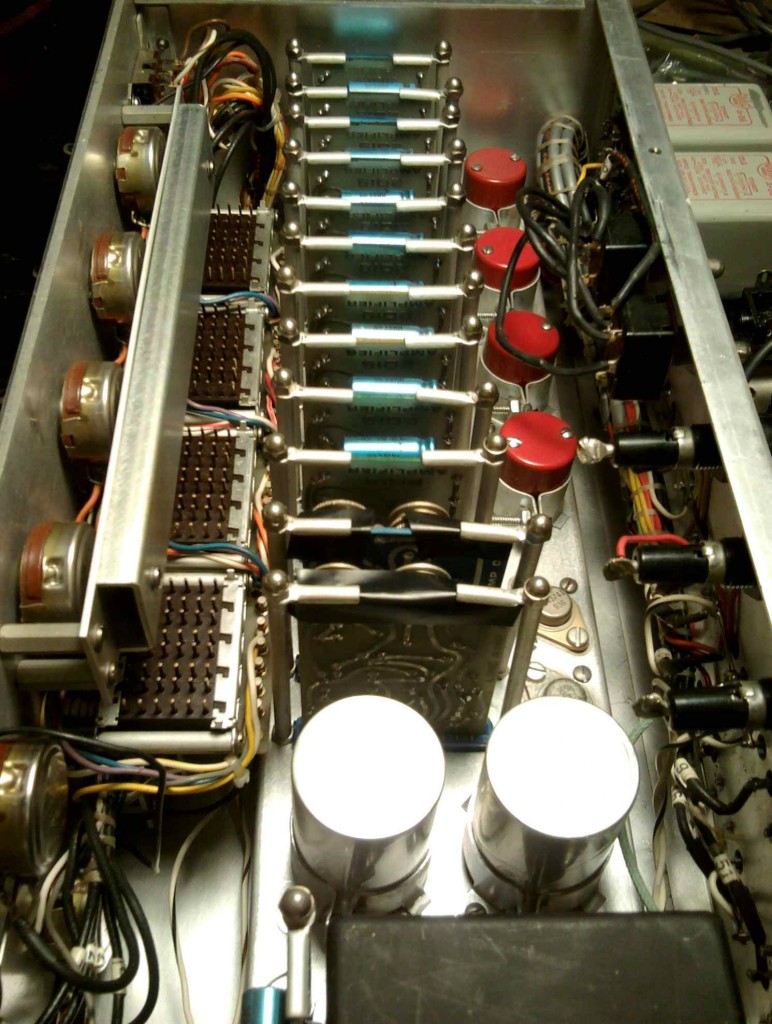 Here’s a picture of the inside of the EM-7 mixer. The build quality is really fantastic and designed for easy service. There are 10 model 2019 amplifier cards and 2 output amplifier cards. All snap in with edge connectors. You will notice the UTC ouncer-series input transformers disguised inside red-painted magnetic shields. Also the UTC A-36 one-watt output transformers. Sealed pots, huge filter caps. etc. Really a nice unit.
Here’s a picture of the inside of the EM-7 mixer. The build quality is really fantastic and designed for easy service. There are 10 model 2019 amplifier cards and 2 output amplifier cards. All snap in with edge connectors. You will notice the UTC ouncer-series input transformers disguised inside red-painted magnetic shields. Also the UTC A-36 one-watt output transformers. Sealed pots, huge filter caps. etc. Really a nice unit.
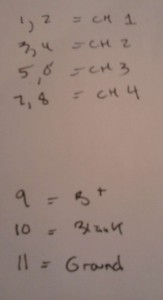 I bought the EM-7 from an eBay seller who I have dealt with before. He stated that the unit ‘probably worked.’ When I got the EM-7, it powered up but it did not pass audio. I suspected that the 11-pin Amphenol socket on the back marked ‘accessory’ might have something to do with this. this seemed a likely place for the EQ unit to attach. After a little poking around, i determined that this was indeed a single receptacle for sending/receiving the 4 channels to the EQ unit as well as supplying power to the EQ unit. I imagine that the EM-7 was originally shipped with an 11-pin ‘dummy plug’ which normals out these send/receive lines. I did not have an 11-pin Amphenol base on-hand, so in order to test the mixer, i make little ‘U’ jumper clips from the base of a 6SN7 tube in order to bridge the 4 send/returns. pins 1/2 are send/receive channel one, 3/4 are send/receive channel 2, 5/6 for ch 3, 7/8 for ch 4. Pin 9 is the B+ (-47v dc), 10 is blank, and 11 is ground.
I bought the EM-7 from an eBay seller who I have dealt with before. He stated that the unit ‘probably worked.’ When I got the EM-7, it powered up but it did not pass audio. I suspected that the 11-pin Amphenol socket on the back marked ‘accessory’ might have something to do with this. this seemed a likely place for the EQ unit to attach. After a little poking around, i determined that this was indeed a single receptacle for sending/receiving the 4 channels to the EQ unit as well as supplying power to the EQ unit. I imagine that the EM-7 was originally shipped with an 11-pin ‘dummy plug’ which normals out these send/receive lines. I did not have an 11-pin Amphenol base on-hand, so in order to test the mixer, i make little ‘U’ jumper clips from the base of a 6SN7 tube in order to bridge the 4 send/returns. pins 1/2 are send/receive channel one, 3/4 are send/receive channel 2, 5/6 for ch 3, 7/8 for ch 4. Pin 9 is the B+ (-47v dc), 10 is blank, and 11 is ground.
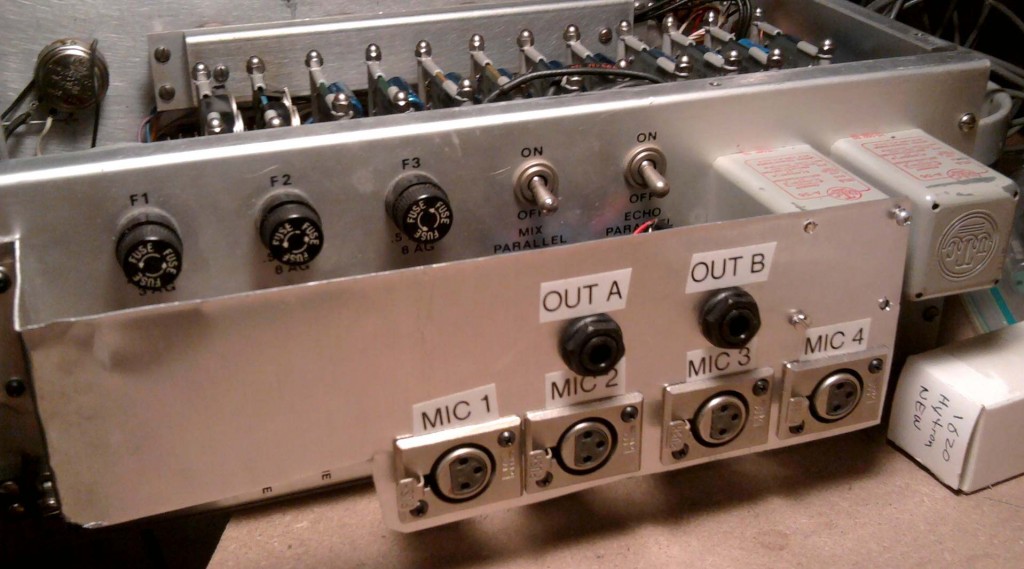 Next step: build and mount a proper jack panel in order top facilitate quick channel input/output switching (the EM-7 has only barrier strips on the rear). I only mounted the 6 connectors that I will use, since I only intend to use this thing as 4×2 mic preamps.
Next step: build and mount a proper jack panel in order top facilitate quick channel input/output switching (the EM-7 has only barrier strips on the rear). I only mounted the 6 connectors that I will use, since I only intend to use this thing as 4×2 mic preamps.
Once I inserted the jumpers, I had proper sound on 3 of the channels and one of the outputs. Then it was a matter of moving the 2019 cards around until I could determine which cards were bad. This was a bit confusing because although all 10 cards are labeled the same, they are actually quite different in terms of gain structure. This is determined by certain caps and resistors on the board. Any of the 10 cards will pass signal in any position, but the gain can be excessive. Anyhow. I determined that one of the mic preamp cards was bad and one of the 2 summing amp cards was bad.
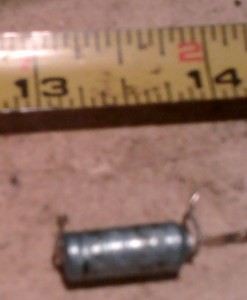 In both cases, the culprit was the same: a 2uf 50v electrolytic cap. Swapped those out, and all was well.
In both cases, the culprit was the same: a 2uf 50v electrolytic cap. Swapped those out, and all was well.
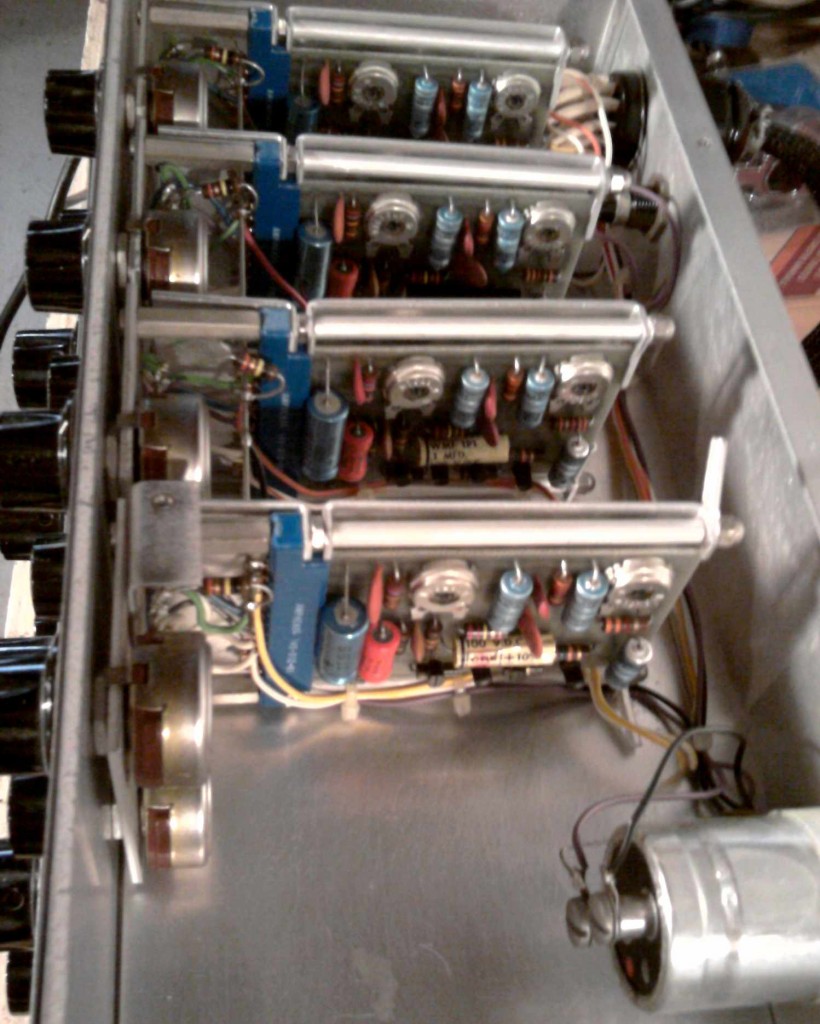 A couple of days later, my EQ-7 until arrived. Here’s a peek at the inside. Again, modular construction which allowed easy troubleshooting. This EQ-7 only had one problem: a filter cap on the 4th board had come loose, which was causing that channel to motorboat at high low-eq boost settings. A few of the 2uf caps in this unit were also below spec. I replaced one to see if it made any improvement in the sound, but i could hear no difference. I imagine that this thing is probably way overbuilt in terms of component values.
A couple of days later, my EQ-7 until arrived. Here’s a peek at the inside. Again, modular construction which allowed easy troubleshooting. This EQ-7 only had one problem: a filter cap on the 4th board had come loose, which was causing that channel to motorboat at high low-eq boost settings. A few of the 2uf caps in this unit were also below spec. I replaced one to see if it made any improvement in the sound, but i could hear no difference. I imagine that this thing is probably way overbuilt in terms of component values.
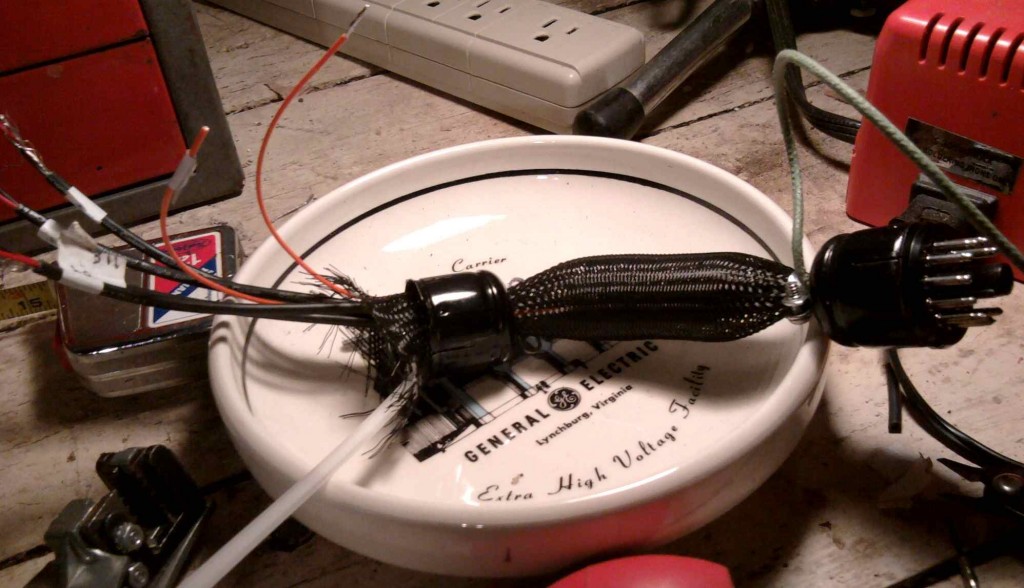 Here’s a view of the 11-pin Amphenol harness that I had to build to connect the units. I found the 11-pin Amphenol connectors at Triode Electronics. the harness is symmetrical and it follows the pinout that I indicated above. I labored to make the harness as short as possible, since it carries unbalanced audio of (presumably) medium impedance.
Here’s a view of the 11-pin Amphenol harness that I had to build to connect the units. I found the 11-pin Amphenol connectors at Triode Electronics. the harness is symmetrical and it follows the pinout that I indicated above. I labored to make the harness as short as possible, since it carries unbalanced audio of (presumably) medium impedance.
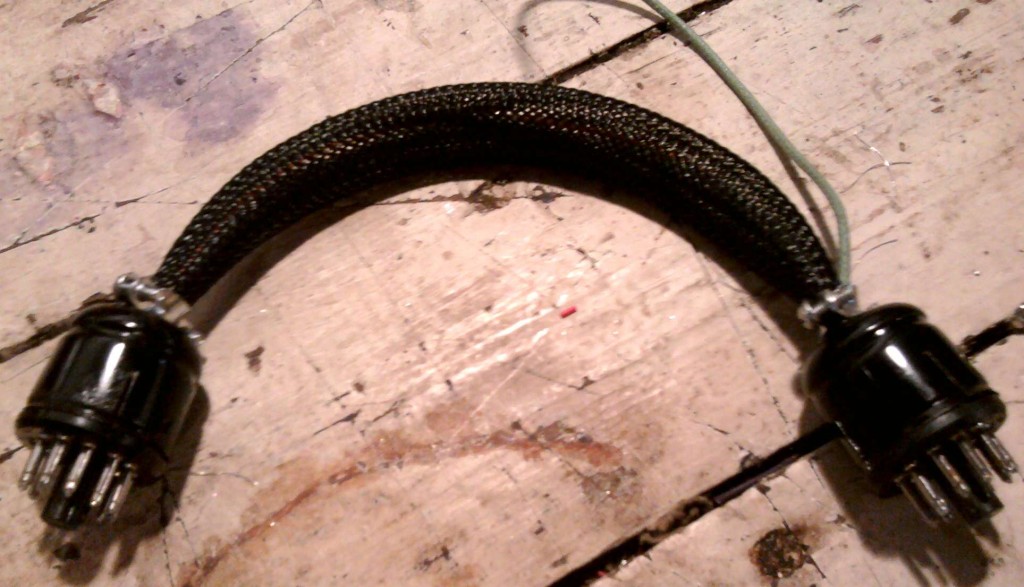 I used belden 24ga shielded audio cable for each send/receive pair. All 4 grounds are brought out on that green wire that is hanging out. This seems to have been unnecessary, as I can hear no difference when I ground that wire to the unit chassis. for the -47 and system ground pins i used 22ga silver braided wire.
I used belden 24ga shielded audio cable for each send/receive pair. All 4 grounds are brought out on that green wire that is hanging out. This seems to have been unnecessary, as I can hear no difference when I ground that wire to the unit chassis. for the -47 and system ground pins i used 22ga silver braided wire.
OK that’s it for now… the Gately system works and sounds great…. expect some audio samples here soon.
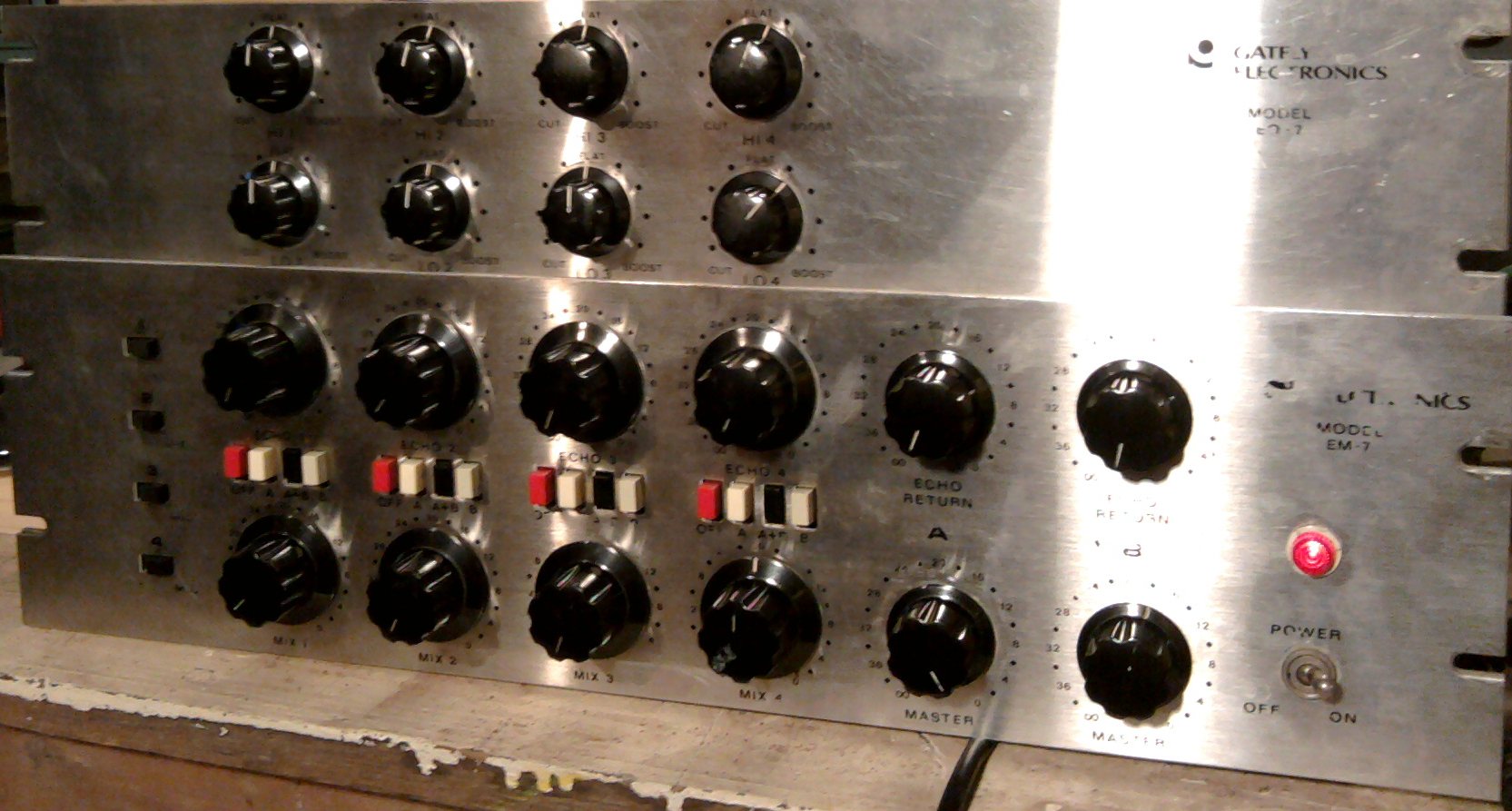
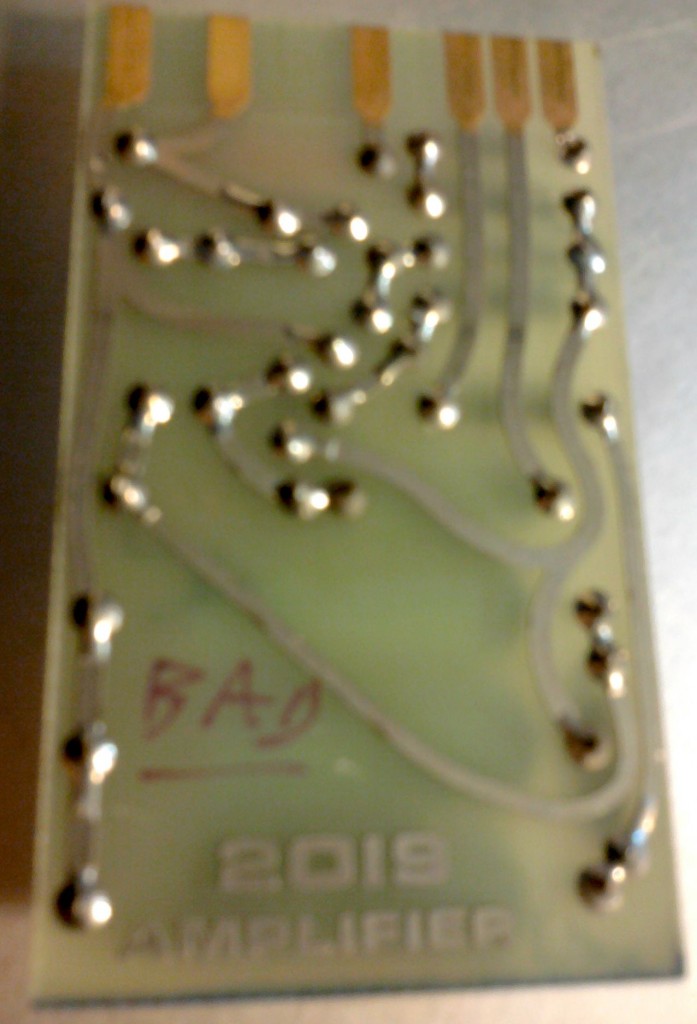
5 replies on “Gately EM-7 Mixer and EQ-7 4-channel Equalizer Unit”
Funny to see a catalog photo of the Fairchild portable mixer. The first studio I worked for, Sonad Recording, had a 16 x 8 version of that board. It was built into a console shell with additional stuff like pan pots and external 8 track monitoring.(Suburban Sound). The studio would take the portable and the Scully 8 track out on remote recordings. Its a good thing the board was light because the 8 track was a beast.
Hi. I’ve searched the net but can’t really find any info past what you offer. I have a few pieces of Gately equipment used by military broadcast setup. Was wondering are they junk. Does ANYbody want them?
Thanx in advance for any advice
John
Depends what you you have. Email me some photos and i can tell you more. Chris at preservationSound dot com
im interrested , i want them!
im interrested , i want them! mike121163atyahoodotcom